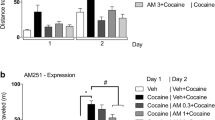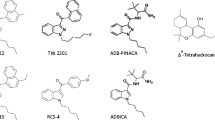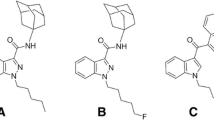Abstract
Rationale
Salvinorin A, the primary psychoactive derivative of the hallucinogenic herb Salvia divinorum, is a potent and highly selective kappa-opioid receptor (KOR) agonist. Several recent studies, however, have suggested endocannabinoid system mediation of some of its effects.
Objectives
This study represents a systematic examination of this hypothesis.
Methods
Salvinorin A was isolated from S. divinorum and was evaluated in a battery of in vitro and in vivo procedures designed to detect cannabinoid activity, including CB1 receptor radioligand and [35S]GTPγS binding, calcium flux assay, in vivo cannabinoid screening tests, and drug discrimination.
Results
Salvinorin A did not bind to nor activate CB1 receptors. In vivo salvinorin A produced pronounced hypolocomotion and antinociception (and to a lesser extent, hypothermia). These effects were blocked by the selective KOR antagonist, JDTic, but not by the CB1 receptor antagonist rimonabant. Interestingly, however, rimonabant attenuated KOR activation stimulated by U69,593 in a [35S]GTPγS assay. Salvinorin A did not substitute for Δ9-tetrahydrocannabinol (THC) in mice trained to discriminate THC.
Conclusions
These findings suggest that similarities in the pharmacological effects of salvinorin A and those of cannabinoids are mediated by its activation of KOR rather than by any direct action of salvinorin A on the endocannabinoid system. Further, the results suggest that rimonabant reversal of salvinorin A effects in previous studies may be explained in part by rimonabant attenuation of KOR activation.






Similar content being viewed by others
References
Baker L, Panos J, Killinger B, Peet M, Bell L, Haliw L, Walker S (2009) Comparison of the discriminative stimulus effects of salvinorin A and its derivatives to U69, 593 and U50, 488 in rats. Psychopharmacology (Berl) 203:203–211
Balster RL, Prescott WR (1992) ∆9-Tetrahydrocannabinol discrimination in rats as a model for cannabis intoxication. Neurosci Biobehav Rev 16:55–62
Barrett RL, Wiley JL, Balster RL, Martin BR (1995) Pharmacological specificity of delta 9-tetrahydrocannabinol discrimination in rats. Psychopharmacology (Berl) 118:419–424
Braida D, Limonta V, Pegorini S, Zani A, Guerini-Rocco C, Gori E, Sala M (2007) Hallucinatory and rewarding effect of salvinorin A in zebrafish: kappa-opioid and CB1-cannabinoid receptor involvement. Psychopharmacology (Berl) 190:441–448
Braida D, Limonta V, Capurro V, Fadda P, Rubino T, Mascia P, Zani A, Gori E, Fratta W, Parolaro D, Sala M (2008) Involvement of kappa-opioid and endocannabinoid system on salvinorin A-induced reward. Biol Psychiatry 63:286–292
Braida D, Capurro V, Zani A, Rubino T, Vigano D, Parolaro D, Sala M (2009) Potential anxiolytic- and antidepressant-like effects of salvinorin A, the main active ingredient of Salvia divinorum, in rodents. Br J Pharmacol 157:844–853
Butelman ER, Harris TJ, Kreek MJ (2004) The plant-derived hallucinogen, salvinorin A, produces kappa-opioid agonist-like discriminative effects in rhesus monkeys. Psychopharmacology (Berl) 172:220–224
Cai TB, Zou Z, Thomas JB, Brieaddy L, Navarro HA, Carroll FI (2008) Synthesis and in vitro opioid receptor functional antagonism of analogues of the selective kappa opioid receptor antagonist (3R)-7-hydroxy-N-((1S)-1-{[(3R, 4R)-4-(3-hydroxyphenyl)-3, 4-dimethyl-1-piperidinyl ]methyl}-2-methylpropyl)-1, 2, 3, 4-tetrahydro-3-isoquinolinecarboxamide (JDTic). J Med Chem 51:1849–1860
Capasso R, Borrelli F, Cascio MG, Aviello G, Huben K, Zjawiony JK, Marini P, Romano B, Di Marzo V, Capasso F, Izzo AA (2008) Inhibitory effect of salvinorin A, from Salvia divinorum, on ileitis-induced hypermotility: cross-talk between kappa-opioid and cannabinoid CB(1) receptors. Br J Pharmacol 155:681–689
Carroll I, Thomas JB, Dykstra LA, Granger AL, Allen RM, Howard JL, Pollard GT, Aceto MD, Harris LS (2004) Pharmacological properties of JDTic: a novel kappa-opioid receptor antagonist. Eur J Pharmacol 501:111–119
Carroll FI, Chaudhari S, Thomas JB, Mascarella SW, Gigstad KM, Deschamps J, Navarro HA (2005) N-substituted cis-4a-(3-hydroxyphenyl)-8a-methyloctahydroisoquinolines are opioid receptor pure antagonists. J Med Chem 48:8182–8193
Chavkin C, Sud S, Jin W, Stewart J, Zjawiony JK, Siebert DJ, Toth BA, Hufeisen SJ, Roth BL (2004) Salvinorin A, an active component of the hallucinogenic sage salvia divinorum is a highly efficacious kappa-opioid receptor agonist: structural and functional considerations. J Pharmacol Exp Ther 308:1197–1203
Cheng Y, Prusoff WH (1973) Relationship between the inhibition constant (K1) and the concentration of inhibitor which causes 50 per cent inhibition (I50) of an enzymatic reaction. Biochem Pharmacol 22:3099–3108
Childers SR (2006) Activation of G-proteins in brain by endogenous and exogenous cannabinoids. AAPS J 8:E112–E207
Gartz J (2001) Salvia divinorum: Die wahrsagesalbei. Nachtschatten Verlag AG, Kronengasse, Switzerland
Ghozland S, Matthes HW, Simonin F, Filliol D, Kieffer BL, Maldonado R (2002) Motivational effects of cannabinoids are mediated by mu-opioid and kappa-opioid receptors. J Neurosci 22:1146–1154
Giroud C, Felber F, Augsburger M, Horisberger B, Rivier L, Mangin P (2000) Salvia divinorum: an hallucinogenic mint which might become a new recreational drug in Switzerland. Forensic Sci Int 112:143–150
Gonzalez D, Riba J, Bouso JC, Gomez-Jarabo G, Barbanoj MJ (2006) Pattern of use and subjective effects of Salvia divinorum among recreational users. Drug Alcohol Depend 85:157–162
Haller VL, Stevens DL, Welch SP (2008) Modulation of opioids via protection of anandamide degradation by fatty acid amide hydrolase. Eur J Pharmacol 600:50–58
Hampson RE, Mu J, Deadwyler SA (2000) Cannabinoid and kappa opioid receptors reduce potassium K current via activation of G(s) proteins in cultured hippocampal neurons. J Neurophysiol 84:2356–2364
Martin BR, Compton DR, Thomas BF, Prescott WR, Little PJ, Razdan RK, Johnson MR, Melvin LS, Mechoulam R, Ward SJ (1991) Behavioral, biochemical, and molecular modeling evaluations of cannabinoid analogs. Pharmacol Biochem Behav 40:471–478
National Research Council (1996) Guide for the care and use of laboratory animals. National Academy Press, Washington
Navarro HA, Howard JL, Pollard GT, Carroll FI (2009) Positive allosteric modulation of the human cannabinoid (CB) receptor by RTI-371, a selective inhibitor of the dopamine transporter. Br J Pharmacol 156:1178–1184
Ortega A, Blount J, Manchand B (1982) Salvinorin, a new lrans-neoclerodane diterpene from Salvia divinorum (Labiatae). J Chem Soc Perkin Trans 1:2505–2508
Roth BL, Baner K, Westkaemper R, Siebert D, Rice KC, Steinberg S, Ernsberger P, Rothman RB (2002) Salvinorin A: a potent naturally occurring nonnitrogenous kappa opioid selective agonist. Proc Natl Acad Sci USA 99:11934–11939
Schultes R (1979) Plants of the gods: their sacred, healing, and hallucinogenic powers. Healing Arts, Rochester
Selley DE, Stark S, Sim LJ, Childers SR (1996) Cannabinoid receptor stimulation of guanosine-5′-O-(3-[35S]thio)triphosphate binding in rat brain membranes. Life Sci 59:659–668
Siebert DJ (1994) Salvia divinorum and salvinorin A: new pharmacologic findings. J Ethnopharmacol 43:53–56
Smith PB, Welch SP, Martin BR (1993) nor-Binaltorphimine specifically inhibits ∆9-tetrahydrocannabinol-induced antinociception in mice without altering other pharmacological effects. J Pharmacol Exp Ther 268:1381–1387
Smith PB, Welch SP, Martin BR (1994) Interactions between delta 9-tetrahydrocannabinol and kappa opioids in mice. J Pharmacol Exp Ther 268:1381–1387
Thomas BF, Gilliam AF, Burch DF, Roche MJ, Seltzman HH (1998) Comparative receptor binding analyses of cannabinoid agonists and antagonists. J Pharmacol Exp Ther 285:285–292
Thomas BF, Francisco ME, Seltzman HH, Thomas JB, Fix SE, Schulz AK, Gilliam AF, Pertwee RG, Stevenson LA (2005) Synthesis of long-chain amide analogs of the cannabinoid CB1 receptor antagonist N-(piperidinyl)-5-(4-chlorophenyl)-1-(2, 4-dichlorophenyl)-4-methyl-1H-pyra zole-3-carboxamide (SR141716) with unique binding selectivities and pharmacological activities. Bioorg Med Chem 13:5463–5474
Turu G, Hunyady L (2010) Signal transduction of the CB1 cannabinoid receptor. J Mol Endocrinol 44:75–85
Valdes LJ 3rd (1994) Salvia divinorum and the unique diterpene hallucinogen, salvinorin (divinorin) A. J Psychoactive Drugs 26:277–283
Valdes LJ 3rd, Diaz JL, Paul AG (1983) Ethnopharmacology of ska Maria Pastora (Salvia divinorum, Epling and Jativa-M.). J Ethnopharmacol 7:287–312
Valdes LJ III, Butler WM, Hatfield GM, Paul AG, Koreeda M (1984) Divinorin A, a psychotropic terpenoid, and divinorin B from the hallucinogenic Mexican mint, Salvia divinorum. J Org Chem 49:4716–4720
Vann RE, Warner JA, Bushell K, Huffman JW, Martin BR, Wiley JL (2009) Discriminative stimulus properties of Delta9-tetrahydrocannabinol (THC) in C57Bl/6 J mice. Eur J Pharmacol 615:102–107
Wasson R (1962) A new Mexican psychotropic drug from the mint family. Botanical Museum Leaflets Harvard University 20:77–84
Wiley JL (1999) Cannabis: discrimination of “internal bliss”? Pharmacol Biochem Behav 64:257–260
Wiley JL, Martin BR (2003) Cannabinoid pharmacological properties common to other centrally acting drugs. Eur J Pharmacol 471:185–193
Wiley JL, Burston JJ, Leggett DC, Alekseeva OO, Razdan RK, Mahadevan A, Martin BR (2005) CB1 cannabinoid receptor-mediated modulation of food intake in mice. Br J Pharmacol 145:293–300
Willmore-Fordham CB, Krall DM, McCurdy CR, Kinder DH (2007) The hallucinogen derived from Salvia divinorum, salvinorin A, has kappa-opioid agonist discriminative stimulus effects in rats. Neuropharmacology 53:481–486
Zhang Y, Butelman ER, Schlussman SD, Ho A, Kreek MJ (2005) Effects of the plant-derived hallucinogen salvinorin A on basal dopamine levels in the caudate putamen and in a conditioned place aversion assay in mice: agonist actions at kappa opioid receptors. Psychopharmacology (Berl) 179:551–558
Acknowledgments
This research is supported by National Institutes of Health/National Institute on Drug Abuse grant DA-03672.
Author information
Authors and Affiliations
Corresponding author
Rights and permissions
About this article
Cite this article
Walentiny, D.M., Vann, R.E., Warner, J.A. et al. Kappa opioid mediation of cannabinoid effects of the potent hallucinogen, salvinorin A, in rodents. Psychopharmacology 210, 275–284 (2010). https://doi.org/10.1007/s00213-010-1827-6
Received:
Accepted:
Published:
Issue Date:
DOI: https://doi.org/10.1007/s00213-010-1827-6




